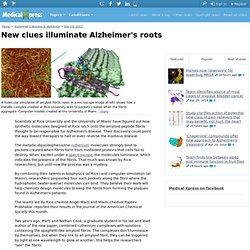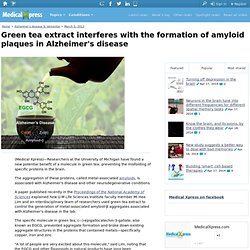

Major Alzheimer's risk factor linked to red wine target. The major genetic risk factor for Alzheimer's disease (AD), present in about two-thirds of people who develop the disease, is ApoE4, the cholesterol-carrying protein that about a quarter of us are born with.

But one of the unsolved mysteries of AD is how ApoE4 causes the risk for the incurable, neurodegenerative disease. In research published this week in The Proceedings of the National Academy of Sciences, researchers at the Buck Institute found a link between ApoE4 and SirT1, an "anti-aging protein" that is targeted by resveratrol, present in red wine. The Buck researchers found that ApoE4 causes a dramatic reduction in SirT1, which is one of seven human Sirtuins. Lead scientists Rammohan Rao, PhD, and Dale Bredesen, MD, founding CEO of the Buck Institute, say the reduction was found both in cultured neural cells and in brain samples from patients with ApoE4 and AD.
"The biochemical mechanisms that link ApoE4 to Alzheimer's disease have been something of a black box. Researchers identify major cause of age-related memory loss. A team of Columbia University Medical Center (CUMC) researchers, led by Nobel laureate Eric R.

Kandel, MD, has found that deficiency of a protein called RbAp48 in the hippocampus is a significant contributor to age-related memory loss and that this form of memory loss is reversible. The study, conducted in postmortem human brain cells and in mice, also offers the strongest causal evidence that age-related memory loss and Alzheimer's disease are distinct conditions. The findings were published today in the online edition of Science Translational Medicine. "Our study provides compelling evidence that age-related memory loss is a syndrome in its own right, apart from Alzheimer's. In addition to the implications for the study, diagnosis, and treatment of memory disorders, these results have public health consequences," said Dr.
The hippocampus, a brain region that consists of several interconnected subregions, each with a distinct neuron population, plays a vital role in memory. New clues illuminate Alzheimer's roots. Scientists at Rice University and the University of Miami have figured out how synthetic molecules designed at Rice latch onto the amyloid peptide fibrils thought to be responsible for Alzheimer's disease.

Their discovery could point the way toward therapies to halt or even reverse the insidious disease. The metallic dipyridophenazine ruthenium molecules strongly bind to pockets created when fibrils form from misfolded proteins that cells fail to destroy. When excited under a spectroscope, the molecules luminesce, which indicates the presence of the fibrils. That much was known by Rice researchers, but until now the process was a mystery. By combining their talents in biophysics (at Rice) and computer simulation (at Miami), researchers pinpointed four such pockets along the fibril where the hydrophobic (water-averse) molecules can bind. This ability to track amyloids was a great step forward, but left open the question of why the complexes latched onto the fibrils at all, Cook said. Green tea extract interferes with the formation of amyloid plaques in Alzheimer's disease.
(Medical Xpress)—Researchers at the University of Michigan have found a new potential benefit of a molecule in green tea: preventing the misfolding of specific proteins in the brain.

The aggregation of these proteins, called metal-associated amyloids, is associated with Alzheimer's disease and other neurodegenerative conditions. A paper published recently in the Proceedings of the National Academy of Sciences explained how U-M Life Sciences Institute faculty member Mi Hee Lim and an interdisciplinary team of researchers used green tea extract to control the generation of metal-associated amyloid-β aggregates associated with Alzheimer's disease in the lab. The specific molecule in green tea, (—)-epigallocatechin-3-gallate, also known as EGCG, prevented aggregate formation and broke down existing aggregate structures in the proteins that contained metals—specifically copper, iron and zinc.
The research team included chemists, biochemists and biophysicists.
Queensland Brain Institute. University of California - Davis. University of Wisconsin. Massachusetts Institute of Technology. University of South Florida. University of North Dakota. Texas Christian University. University of California (San Diego) University of Pennsylvania. University College London. Supplements. Possible Influence.